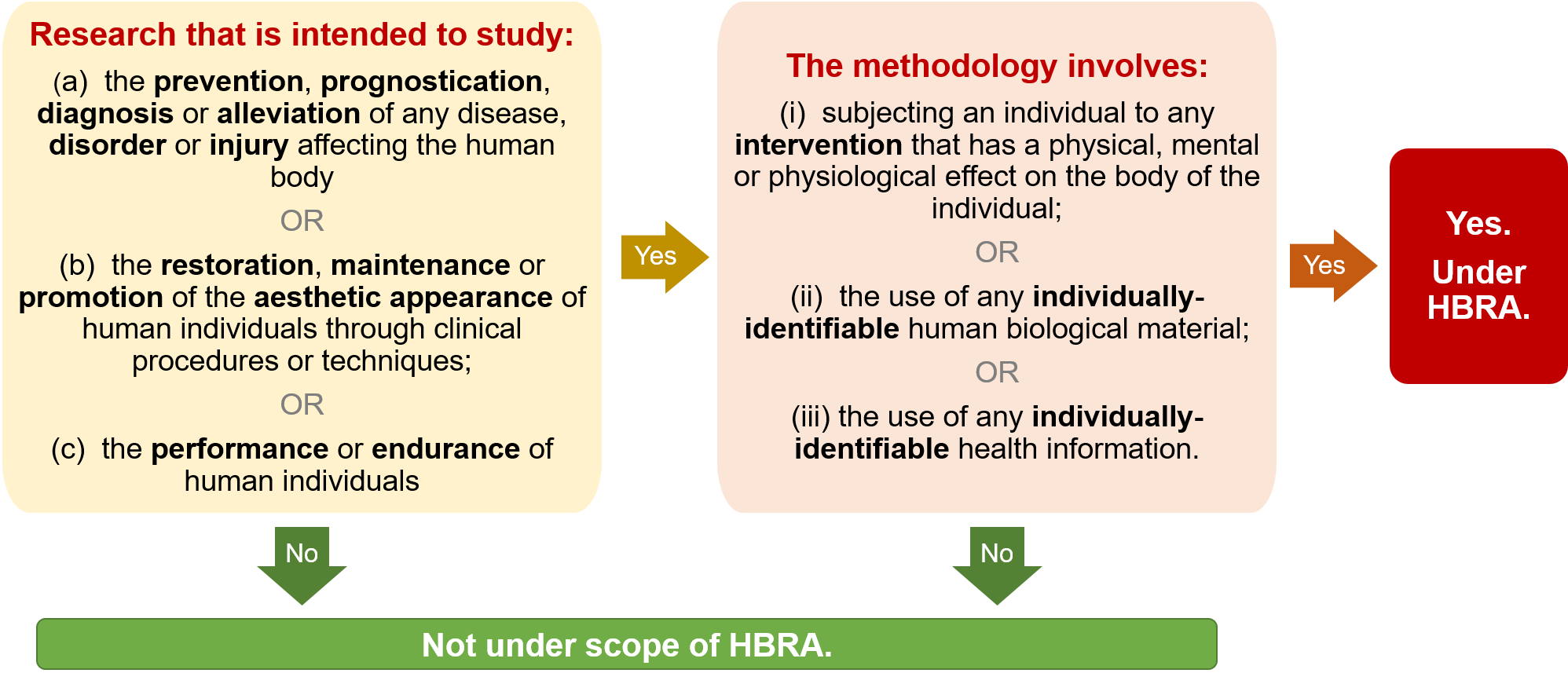HBRA Scope
Does your research fall within the scope of HBRA?
Please note that your study needs to fulfill both Intention and Methodology boxes to be considered as HBR.
You may also refer to the HBR Decision Tool on MOH’s HBRA website.
Notes:
1. ‘Performance or Endurance’ – refers to human limits of performance and endurance (including mental, physiological, and physical functions).
The study of best posture/technique/execution for a specific stroke or action in a sport, if through a direct "intervention" that deviates from an average person’s everyday routine, is likely to be regulated under the HBRA. If the described research involve normal human psychological responses and behaviours (normal gameplay) in healthy individuals to observe parameters like eye-hand coordination, mental agility and alertness, which involves minimal risk to the subjects, this research is unlikely to be regulated under the HBRA.
2. Interventions - Procedures that have physical, mental or physiological effect (whether temporary or permanent) on the body of the research subject. E.g. Venepuncture, MRI, X-rays, etc.
3. Invasive - Procedures that are incisional, i.e. cutting into the tissues of the body. E.g. venepuncture, fingerprick/ skin-prick, muscle biopsy.
4. Clinical Research Materials - Refers to (1) Therapeutic products; or (2) Medicinal products; or (3) Medical devices; that are intended for clinical research. PIs are to check with HSA if their CRM needs to be registered or notified to HSA to comply with legal requirements prior to using the material in research. Please contact HSA Clinical Trials Branch at hsa_ct@hsa.gov.sg.
5. In addition, any research that involves the following are within the scope of HBRA:
a. human gametes or human embryos;
b. cytoplasmic hybrid embryos;
c. the introduction of any human-animal combination embryo into an animal or a human;
d. the introduction of human stem cells (including induced pluripotent stem cells) or human neural cells into an animal at any stage of development (including a prenatal animal foetus or animal embryo); or
e. any entity created as a result of any process referred to in paragraph (c) or (d).
6. Under Schedule 2 of HBRA, the following are excluded from the scope of HBRA:
i. Research and studies on normal human psychological responses and behaviours —
(a) which are not designed or intended to study psychiatric or psychological disorders; and
(b) which involve no more than minimal risk to the research subject.
ii. Research, studies and tests to measure human intelligence —
(a) which are not designed or intended to study mental or intellectual disability; and
(b) which involve no more than minimal risk to the research subject.
7. HBRA is not intended to regulate the following types of studies:
i. Service evaluations - To assess and/or improve healthcare service delivery
ii. Clinical audits - To improve patient care and outcomes
iii. Surveillance - Designed to guide public health policies, programmes and actions to prevent and control the diseases.
iv. Outbreak investigations - Designed to determine the source of the outbreak, and actions are to prevent and control transmission of disease. Findings may also guide public health policies.


